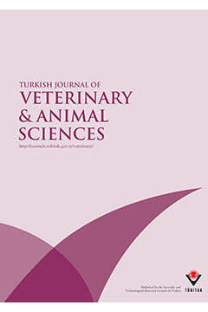The effects of dry-off therapy on milk somatic cell count in Saanen goats
Dairy goat, dry-off therapy, somatic cell count, teat sealant
The effects of dry-off therapy on milk somatic cell count in Saanen goats
Dairy goat, dry-off therapy, somatic cell count, teat sealant,
___
- Silanikove N, Leitner G, Merin U, Prosser CG. Recent advances in exploiting goat’s milk: quality, safety and production aspects. Small Ruminant Res 2010; 89: 110–124.
- Park YW, Juárez M, Ramos M, Haenlein GFW. Physico- chemical characteristics of goat and sheep milk. Small Ruminant Res 2007; 68: 88–113.
- García V, Rovira S, Boutoial K, López MB. Improvements in goat milk quality: a review. Small Ruminant Res 2014; 121: 51–57.
- Souza FN, Blagitz MG, Penna CFAM, Della Libera AMMP, Heinemann MB, Cerqueira MMOP. Somatic cell count in small ruminants: friend or foe? Small Ruminant Res 2012; 107: 65–75.
- Jiménez-Granado R, Sánchez-Rodríguez M, Arce C, Rodríguez-Estévez V. Factors affecting somatic cell count in dairy goats: a review. Span J Agric Res 2014; 12: 133–150.
- Poutrel B, de Crémoux R, Ducelliez M, Verneau D. Control of intramammary infections in goats: impact on somatic cell counts. J Anim Sci 1997; 75: 566–570.
- Shwimmer A, Kenigswald G, Van Straten M, Lavi Y, Merin U, Weisblit L, Leitner G. Dry-off treatment of Assaf sheep: efficacy as a management tool for improving milk quantity and quality. Small Ruminant Res 2008; 74: 45–51.
- Harmon RJ, Eberhart RJ, Langlois DE, Wilson RA. Microbiological Procedures for the Diagnosis of Bovine Udder Infection. 3rd ed. Arlington, VA, USA: National Mastitis Council; 1990.
- Bergonier D, Berthelot X. New advances in epizootiology and control of ewe mastitis. Livest Prod Sci 2003; 79: 1–16.
- Contreras A, Luengo C, Sánchez A, Corrales JC. The role of intramammary pathogens in dairy goats. Livest Prod Sci 2003; 79: 273–283.
- Baştan A. İneklerde Meme Sağlığı ve Sorunları. 2nd ed. Ankara, Turkey: Kardelen Ofset; 2013 (in Turkish).
- Raynal-Ljutovac K, Pirisi A, de Crémoux R, Gonzalo C. Somatic cells of goat and sheep milk: analytical, sanitary, productive and technological aspects. Small Ruminant Res 2007; 68: 126–144.
- Koop G, Nielen M, van Werven T. Bulk milk somatic cell counts are related to bulk milk total bacterial counts and several herd-level risk factors in dairy goats. J Dairy Sci 2009; 92: 4355–4364.
- Paape MJ, Wiggans GR, Bannerman DD, Thomas DL, Sanders AH, Contreras A, Moroni P, Miller RH. Monitoring goat and sheep milk somatic cell counts. Small Ruminant Res 2007; 68: 114–125.
- Paape MJ, Poutrel B, Contreras A, Marco JC, Capuco AV. Milk somatic cells and lactation in small ruminants. J Dairy Sci 2001; 84: 237–244.
- Berry EA, Hillerton JE. The effect of an intramammary teat seal on new intramammary infections. J Dairy Sci 2002; 85: 2512–2520.
- Bradley AJ, Green MJ. The potential impact of the dry period on environmental mastitis – a preliminary assessment of the UK field situation. In: Proceedings of the 38th Annual Meeting of the National Mastitis Council. Madison, WI, USA: National Mastitis Council; 1999. pp. 106–114.
- Wilson CD, Westgarth DR, Kingwill RG, Griffin TK, Neave FK, Dodd FH. The effect of infusion of sodium cloxacillin in all infected quarters of lactating cows in sixteen herds. Brit Vet J 1972; 128: 71–85.
- Smith KL, Todhunter DA, Schoenberger PS. Environmental mastitis: cause, prevalence, prevention. J Dairy Sci 1985; 68: 1531–1553.
- Oliver SP. Frequency of isolation of environmental mastitis- causing pathogens and incidence of new intramammary infection during the nonlactating period. Am J Vet Res 1988; 48: 1789–1793.
- Sánchez J, Montes P, Jiménez A, Andrés S. Prevention of clinical mastitis with barium selenite in dairy goats from a selenium- deficient area. J Dairy Sci 2007; 90: 2350–2354.
- Huxley JN, Greent MJ, Green LE, Bradley AJ. Evaluation of the efficacy of an internal teat sealer during the dry period. J Dairy Sci 2002; 85: 551–561.
- Bradley AJ, Leach KA, Breen JE, Green LE, Green MJ. Survey of the incidence and aetiology of mastitis on dairy farms in England and Wales. Vet Rec 2007; 160: 253–258.
- Bradley AJ, Breen JE, Payne B, Williams P, Green MJ. The use of a cephalonium containing dry cow therapy and an internal teat sealant, both alone and in combination. J Dairy Sci 2010; 93: 1566–1577.
- Bastan A, Cengiz M, Cengiz S, Polat B, Colak A, Akan M, Darbaz I, Acar DB. Effects of precalving antibiotic treatment on mastitis and individual somatic cell count in heifers. J Anim Vet Adv 2010; 9: 1245–1249.
- Sampimon O, Barkema HW, Berends I, Sol J, Lam T. Prevalence of intramammary infection in Dutch dairy herds. J Dairy Res 2009; 76: 129–136.
- Rabiee AR, Lean IJ. The effect of internal teat sealant products (Teatseal and Orbeseal) on intramammary infection, clinical mastitis, and somatic cell counts in lactating dairy cows: a meta-analysis. J Dairy Sci 2013; 96: 6915–6931.
- ISSN: 1300-0128
- Yayın Aralığı: 6
- Yayıncı: TÜBİTAK
SANG IN LEE, HYUN SOO KIM, INHO KIM
Sung Woo KIM, Jin Seok CHOI, Neelesh SHARMA, Yeoung Gyu KO, Yoon Jung DO, Mijeong BYUN, Hwan Hoo SEONG, Soo Bong PARK, Dong Kee JEONG
Frequency of hoof conformation faults and disorders in horses of several breeds
Jaroslaw LUSZCZYNSKI, Magdalena PIESZKA, Anna DURMALA, Weronika PISARCZYK, Romana AUGUSTYN, Boguslawa DLUGOSZ
Breed, parity, and cycle season effects on life-timereproduction in bitches: a retrospective study
BÜLENT POLAT, ARMAĞAN ÇOLAK, MEHMET CENGİZ, ORÇUN CANNAZİK, ARMAĞAN HAYIRLI
The effects of different salting and preservation techniques ofkaşar cheese on cheese quality
Asya ÇETİNKAYA, Mustafa ATASEVER
Heparin-induced in vitro capacitation changes of swamp buffalo spermatozoa
Dibyajyoti TALUKDAR, Kutubuddin AHMED, Sourabh DEORI, Gopal Chandra DAS
Evren ERDEM, Esin Ebru ONBAŞILAR, Özlem Gücüyener HACAN
Mohammed ABDELHAKIEM, Yuuhi ASAI, Hiroaki KAMISHINA, Masaaki KATAYAMA, Yuji UZUKA
BETANIA MONTEIRO, LUKIYA FAVARATO, PABLO CARVALHO, BARBARA OKANO, MARIA ANTONIA MENEGATTI, ALVARO OLIVEIRA, BIANKA SANTOS, RICARDO DEL CARLO
